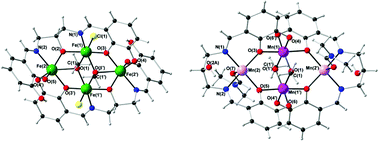Di-, tetra- and hexanuclear iron(III), manganese(II/III) and copper(II) complexes of Schiff-base ligands derived from 6-substituted-2-formylphenols†
Abstract
Acyclic

* Corresponding authors
a
Institut für Anorganische Chemie der Universität Karlsruhe, Engesserstrasse Geb. 30.45, Karlsruhe, Germany
E-mail:
powell@aoc.uni-karlsruhe.de
b CNRS, UPR 8641, Centre de Recherche Paul Pascal (CRPP), Equipe “Matériaux Moléculaires Magnétiques”, 115 avenue du Dr. Albert Schweitzer, Pessac, France
c Université de Bordeaux, UPR 8641, Pessac, France
d
Department of Chemistry and The MacDiarmid Institute for Advanced Materials and Nanotechnology, University of Otago, PO Box 56, Dunedin, New Zealand
E-mail:
sbrooker@chemistry.otago.ac.nz
Acyclic

 Please wait while we load your content...
Something went wrong. Try again?
Please wait while we load your content...
Something went wrong. Try again?
Y. Lan, G. Novitchi, R. Clérac, J. Tang, N. T. Madhu, I. J. Hewitt, C. E. Anson, S. Brooker and A. K. Powell, Dalton Trans., 2009, 1721 DOI: 10.1039/B818113F
To request permission to reproduce material from this article, please go to the Copyright Clearance Center request page.
If you are an author contributing to an RSC publication, you do not need to request permission provided correct acknowledgement is given.
If you are the author of this article, you do not need to request permission to reproduce figures and diagrams provided correct acknowledgement is given. If you want to reproduce the whole article in a third-party publication (excluding your thesis/dissertation for which permission is not required) please go to the Copyright Clearance Center request page.
Read more about how to correctly acknowledge RSC content.
 Fetching data from CrossRef.
Fetching data from CrossRef.
This may take some time to load.
Loading related content
